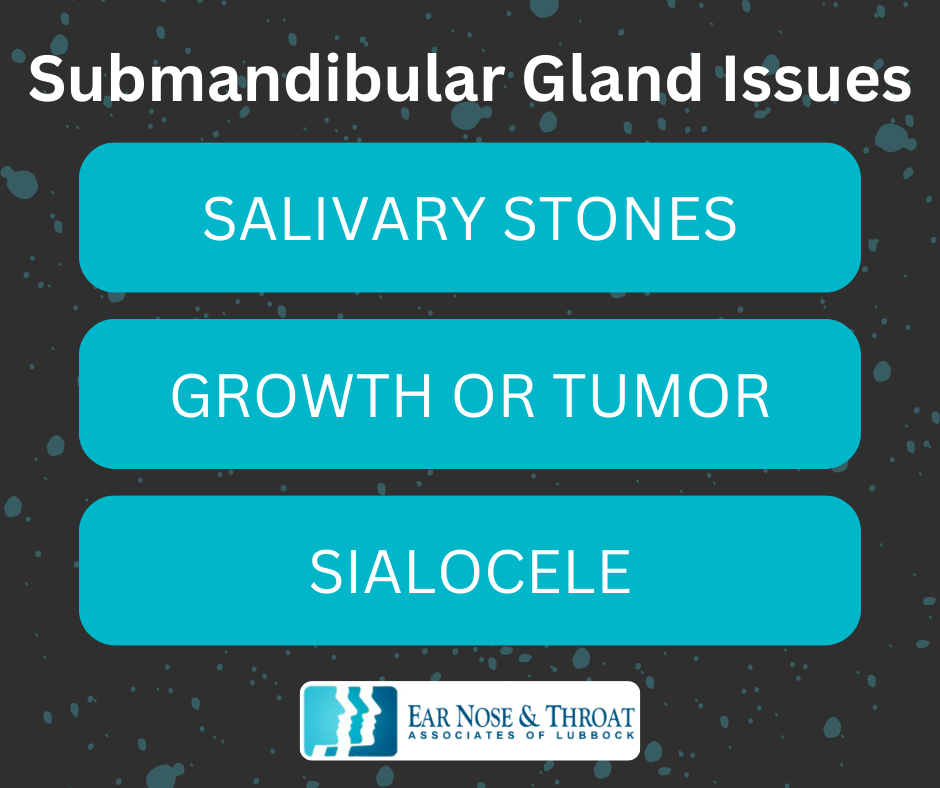What to Expect Before and After Submandibular Gland Excision

Saliva probably isn’t something you think about too often, but your salivary glands work hard every day to ensure you have enough of it. One of these hard-working glands is called the submandibular gland.
Unfortunately, things can sometimes go awry with this gland’s production and delivery of saliva. Treating these issues often involves a submandibular gland excision, meaning we remove the affected gland.
Below, we go into greater detail to help you understand the procedure, its effects, and what to expect before and after surgery.
What Does the Submandibular Gland Do?
The submandibular gland is a salivary gland under your jaw. Its job is to produce saliva, which then empties into your mouth through small openings underneath your tongue called ducts.
If you’ve ever heard of “gleeking,” then you’re probably familiar with how this works. When people gleek, saliva shoots out of their mouths, usually while talking, yawning, or eating. That spit comes from the submandibular gland via the ducts beneath the tongue.
Generally, this bodily system works like a well-oiled machine. However, people can sometimes develop issues that inhibit this natural process, such as:
- Salivary stones, which can obstruct the duct and prevent the normal flow of saliva into your mouth, causing swelling in the jaw area.
- Growth or tumor on the gland, either benign or cancerous.
- Sialocele, or salivary mucocele, which involves the accumulation of saliva or mucus that isn’t draining properly. As a result, the gland can bulge and cause uncomfortable swelling in the neck.

What Is Submandibular Gland Excision Surgery?
A submandibular gland excision is a surgical procedure in which we remove the affected submandibular gland entirely. We take this step after careful consideration and testing to identify the source of the problem.
Losing a salivary gland may sound alarming. Don’t you need all that saliva production?
No need to worry. Even with the loss of a submandibular gland, you’re not signing up for a lifetime of dry mouth. You have plenty of other salivary glands that are more than capable of keeping your mouth hydrated.
How to Prepare for Submandibular Gland Excision Surgery
A submandibular gland excision involves very little prep work on your end:
- If you have a beard, shave it a few days before the surgery so we can easily access the incision site. (However, please do not shave the day before surgery, which could lead to infections.)
- Shower with antibacterial soap the night before the procedure.
- Avoid eating or drinking after midnight the night before your surgery. This makes general anesthesia much safer.
Also, watch for communication from our office shortly after your procedure is scheduled to provide general details and estimated costs, and then again a day or two before your procedure to discuss specific details and the time of your upcoming surgery.
What Happens During a Submandibular Gland Excision?
During the surgery, we make a two-inch incision underneath your jawbone. Then, we dissect the area around the submandibular gland, carefully ligating the facial artery to access it.
As we navigate around the gland, we’re cautious not to damage the nearby nerves, including the hypoglossal and lingual nerves, which affect tongue movement and sensations. We also take special precautions to protect the marginal mandibular nerve, which runs along your jaw and affects your ability to move the corners of your mouth.
Once we identify and separate the surrounding structures from the gland, we carefully remove it. We then use dissolvable sutures to close the wound and apply Steri-Strip bandages to secure it. Depending on the gland’s size and state, we may also insert a drain to prevent fluid accumulation in the area.
What Does Recovery Look Like?
If you received a drain, you’ll come to the clinic the day after surgery so we can remove it. Otherwise, you’ll have a follow-up visit in one week to remove the Steri-Strips and ensure the incision site is healing well.
You can shower 24 hours after the procedure, but avoid high water pressure directly on the incision site. You should wash gently with soap and water and pat the area dry afterward. We ask you not to submerge the wound in water, such as in a bathtub or pool, until the site is fully healed.
You can follow a regular diet immediately after surgery. However, avoid any strenuous activity or heavy lifting for about a week.
What Are the Risks of Submandibular Gland Excision?
One risk associated with a submandibular gland excision is a potential fluid buildup under the surface of the skin at the incision site. Your body usually absorbs this fluid over time, but we can also drain the fluid with a small needle if there’s a significant amount.
A more significant risk of this procedure is the potential for damage to nerves near the gland. Sometimes, the nerves experience some trauma simply from being pulled during the procedure, and they just need a little time to recover. If a nerve is divided during surgery, however, it will have a harder time recovering, though that risk is reduced with an experienced ENT.
Conclusion
If you need a submandibular gland excision, finding a highly experienced ENT is one of the best steps you can take to reduce the risks. And remember — your other salivary glands will still be there doing their job!
Dr. Cuthbertson is a physician at Ear Nose & Throat Associates of Lubbock. He joined the team at ENT Lubbock from Houston, where he was chief resident of the prestigious Bobby R. Alford Department of Otolaryngology at Baylor College of Medicine. He is board certified in Otolaryngology and Head & Neck Surgery and has quickly built a reputation, not only as an extremely skilled surgeon, but as an approachable and compassionate clinician adept in the newest standards and technologies. Learn more about Dr. Cuthbertson.
Categories:








